 When a game incorporates all of my favorite mechanics into one I always find it hard to resist. It means I get an opportunity to exercise both puzzle-solving skills and management in all forms. Complexity in game mechanics also translates to room for self-improvement as a player, and with its vibrant colors, this game had to make it to my table.
When a game incorporates all of my favorite mechanics into one I always find it hard to resist. It means I get an opportunity to exercise both puzzle-solving skills and management in all forms. Complexity in game mechanics also translates to room for self-improvement as a player, and with its vibrant colors, this game had to make it to my table.
Oros is a grid movement and worker placement game for 1-4 players that takes about two hours to play. The best experience is with 3 players for a good balance of competition and time investment.
Gameplay Overview:
After setting up the map board and placing starting tiles and volcanoes, players in turn order all take the same three actions for their first turn: assigning a follower to any unoccupied island tile, and assigning the other two followers to unoccupied action spaces on their player mat to take the corresponding action. For subsequent turns, it is up to the player to decide which three actions to take.
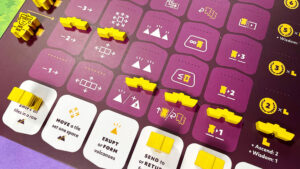
The available actions in the game are Shift, Move, Volcano, Study, Journey, and Build. Within each action type are six levels of ability that can be unlocked over time with wisdom, making the action more powerful. Wisdom can be gained by returning followers from study, building a sacred site, or having a follower studying on your own sacred site when another player builds on the same mountain.
The gameplay focuses on using these actions to manipulate the grid and its volcanoes in order to create mountains, which provides opportunities for followers to journey and build sacred sites. Sacred sites are important for the demigod’s ascension on the track, gaining wisdom to unlock various abilities and knowledge point gains on the player mat, and overall more knowledge points for final scoring.
The game end is triggered when a player ascends to the topmost space on the ascension track, and players finish out the current round. During final scoring, knowledge points are determined by the ascension track, unlocked points from abilities, unlocked multipliers for followers in study, and unlocked multipliers for sacred sites. The player with the greatest number of knowledge points wins.
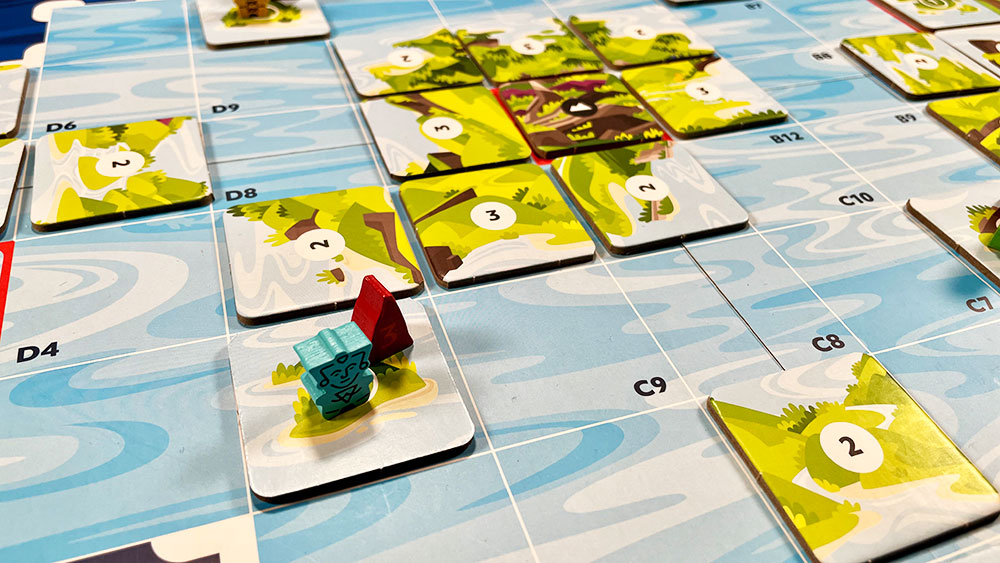
Game Experience:
The first thing I noticed is that this game takes up so much table space between the large map, additional tiles, pieces, and player mat. For those of you that have formal game tables it shouldn’t be an issue but if you’re mainly playing on a dining room table you may need to get creative with the space. I understand why the components are sized the way they are and how it can drive the corresponding sizes of the mats, but setup gets tricky for a full table of players. For the game setup to be manageable I also had to use several of my own bags to get all of the pieces organized for the players and even more bags to sort out tile types.
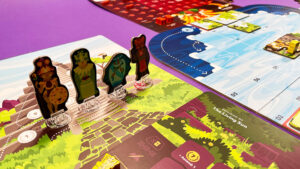
Oros’ main draw is grid movement but its tile-shifting process just adds more housekeeping time to the game as players may lose their place while shifting. It is hard to undo any mistakes if they aren’t sure which tiles have been moved or not, and this is especially true when diagonal movement is unlocked. However, if executed properly, the wide range in tile shifting adds a great take-that element to shake the foundations of opponents’ intended movement for their followers. That being said we didn’t find that it was necessary in our game to try diagonal movement as most advantageous moves were possible just shifting orthogonally. It seems like the added flexibility contributes to more confusion than anything else and just because you can do something in a game doesn’t mean you need to.
Sacred sites, which are the main way to gain points, must be built on mountain tiles. This means the first objective in overall gameplay is to shift tiles such that mountain tiles are built at advantageous spots in relation to your followers’ locations on the map. From there, it can become a timing issue of trying to build more lucrative sacred sites that lead to more wisdom, which requires you to wait on your opponents to build first. I enjoyed the positioning tactics and planning ahead leading up to building these sacred sites, finding it to be one of the more immersive aspects of movement. I also loved the directional puzzle surrounding the use of volcanoes and creating new land tiles with them. They felt intuitive, based on how islands are formed in the real world, and excited to open up new opportunities for mountains in one action.
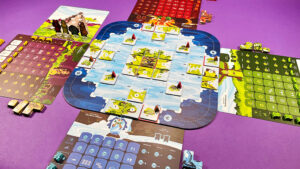
Amidst the complexity of available actions, the ability advancements on the player mat give players something to work toward when things get chaotic. There was good tension in deciding whether to focus on reaching the top of a track or spreading the wisdom evenly such that new followers are unlocked or study points augmented. In this way, we see players’ individual strategy and comfort with the game mechanics come through as they were more likely to invest wisdom into abilities they took advantage of regularly. I have to admit that it was delightful to make powerful upgraded moves with well-invested wisdom while my opponents were scrambling with old ways of doing things. The feeling of having more flexibility due to knowledge was reminiscent of tech trees in video games like Civilization or in other board games like Gaia Project.
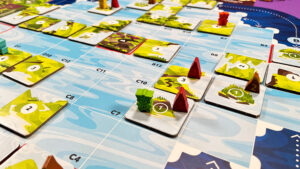
The two main issues I see with Oros are the automa design and the rule technicalities throughout nearly every game mechanic. The automa seems unnecessarily powerful as it has access to moves that real players do not, like removing followers and removing tiles. It is more of a powerful annoyance than a well-thought-out additional player. Oros also claims to have a solo mode but what it really means is you play the game normally with two automa, which is not at all interesting. In this case, the challenge is because you’re playing against a “player” that has an advantage, not that a new way of playing the game is presented.
As for rule technicalities, in my opinion, it’s a bad sign if you need to add in a common mistakes section in your rulebook. What this means to me is that the game’s complexity and corresponding mechanics are not intuitive to the players. They’ll spend their first game trying to unlearn what the design deems as a bad habit and only on a second or third play fully grasp what is expected of them.
Final Thoughts:
Oros is for players who enjoy a spatial, grid movement puzzle that comes with aspects of worker placement and technology trees. They’ll find themselves with challenges to mitigate the take-that element of a constantly shifting landscape, volcanoes that create new opportunities, and an automa that has unexpected powers. However, players who do not enjoy complexity for complexity’s sake and prefer more intentional game mechanics may not enjoy the level of housekeeping involved in gameplay or technicalities. While some players may see an automa with unique abilities as a fun challenge, others may consider it more of a half-baked annoyance. Wherever you may fall on this range of experiences with this game, all players can expect to strategize and compromise in this world of Demigods.
Final Score: 3 Stars – Share your knowledge with your followers as a Demigod in this puzzling game of grid movement.
 Hits:
Hits:
• Volcano mechanic creates a fun puzzle
• Shifting map adds a refreshing take-that element
• Tech tree board brings civ-builder nostalgia
Misses:
• Housekeeping takes away from the fun
• Rule technicalities create frustration
• Automa seems half-baked





















